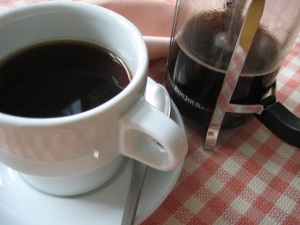Coffee Talk: Brewing the Perfect Cup
 Tuesday, September 28, 2010 at 4:00AM
Tuesday, September 28, 2010 at 4:00AM In my mother’s kitchen hangs a framed print of an iconic Saturday Evening Post illustration. It depicts a schoolgirl (think young June Cleaver) at the knee of her grandmother, learning to fulfill the first duty (okay, maybe second) of every aspiring housewife: making coffee. While the exhibition of this oppressive advertisement in our liberated kitchen is tongue in cheek, its point (minus that whole cult of domesticity nonsense) is well taken; everyone should know how to make a good cup of joe.
So, let’s reframe the picture. Instead of “what every young girl should know” make it, “what every man, woman, child, artificial intelligence, and clever pet should know.” And as for the simple rules, “use a heaping tablespoon for every cup and keep your utensils clean!” Cruelly vague.
Like so many simple things, coffee can be rather hard to do well. Even our test kitchen’s seasoned culinarians had to fiddle with the grounds-to-water ratio when bestowed with a French press, and still it seems that some of us just have the touch when it comes to making a nice strong, but balanced brew.
That said, there are certainly rules to live by that will set you on the path to great coffee.
THE RULES
Roast: A Happy Medium
Dark roast seems to be en vogue, but most coffee aficionados I’ve known prefer a medium roast and I wholly agree. When coffee beans are harvested [pic] they are vibrant in color and flavor. Roasting dries the beans, while pleasantly rounding and intensifying their flavors. But roasting for too long will kill coffee’s best notes and accentuate its worst. Coffee is bitter enough as it is, without adding acrid notes of char. Plus, dark roasting burns off the grassy, floral and nutty subtleties that make each variety unique.
Grind: A la Minute
 Buy whole beans and grind only as much as you need just before brewing. Grinding exponentially increases a beans surface area, releasing the flavor and aroma that belongs in your cup! All that exposure to air also speeds spoilage, so given the price tag of quality coffee, grinding to order is highly economical. Not only will your brew taste better and cost less, it will be healthier, as coffee’s natural antioxidants are most readily available when fresh.
Buy whole beans and grind only as much as you need just before brewing. Grinding exponentially increases a beans surface area, releasing the flavor and aroma that belongs in your cup! All that exposure to air also speeds spoilage, so given the price tag of quality coffee, grinding to order is highly economical. Not only will your brew taste better and cost less, it will be healthier, as coffee’s natural antioxidants are most readily available when fresh.
Equipment – Coffee grinders are relatively inexpensive appliances that don’t take up much real estate. They also serve double duty when used to grind whole spices, like coriander seed, increasing the flavor and extending the shelf life of your spice rack. To clean between applications, simply pulse some salt or sugar and discard.
Ratio: 2 level tablespoons of grounds to 1 cup water
Brewing: The 3 Ts
Time – 3 ½ to 4 minutes
(If you care to impress your dinner guests, this time frame allows for 19 to 21% extraction; enough to impart all the enjoyable coffee flavors and aromatics without allowing the bitter notes to seep in.)
Temperature - The ideal temperature for brewing coffee is 192 degrees. If boiling water, bring to a rolling boil then rest for 1 minute before pouring over grounds. If using a brewer, choose one that has a temperature gauge. (see below for brewer rec’s)
Turbulence - If brewing in a French press, do stir. Aerating releases the flavor and creates a delightful layer of crema.
Equipment:
Drip Brewer: Spring for a good one (most are in the $200 range). In the case of brewers, you get what you pay for and, like a good pair of shoes, the everyday wear pays for itself!
I have used and enjoyed…Cuisinart 12-cup Fully Automatic Burr Grind & Brew Thermal Coffeemaker and Technivorm Moccamaster CD-Thermo
French Press: My Sunday morning standby is a BonJour French Press, which I favor for its “flavor lock” feature, which allows you to block off the grounds from the water, to prevent overbrewing, perfect for a lazy morning with the paper.
Grind beans more coarsely when using a French press to avoid coffee that is murky with sediment.
Stovetop: Whether brewed in an Ibrik (Turkish coffee maker) or a Moka (Italian espresso pot) this method calls for powder-like grounds and water to be heated slowly over a flame. It requires some technique, but for those who like a nice strong cup of coffee, it’s worth a tutorial. Note: this category does not include percolators, which I don’t recommend.
This Just In! New on the caffeine scene is the Clever Coffee Dripper. It’s an amalgamation of drip brewer and French Press that may be coffee’s new best friend.
Special Fork bloggers blog Monday through Friday. For more recipes and ideas on your smartphone, check us out at www.specialfork.com. Join the conversation on Facebook and follow us on Twitter @specialforksndy.


Reader Comments